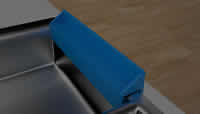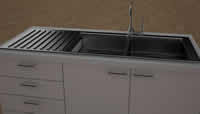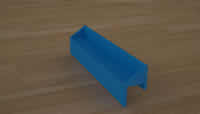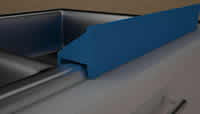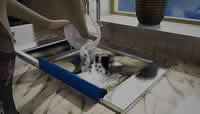Purpose & Benefits
- Provides a splashguard to prevent water from hitting a user while washing dishes in a sink.
- Eliminates the need to wear an apron or other protective garment while doing dishes.
- Decreases the risk of delicate clothing becoming stained or damaged.
- Offers permanent and removable configurations.
Problems Solved
The Sink Apron is a splashguard that attaches to the front edge of a kitchen sink to protect a user’s clothing while washing dishes. The invention comprises an elongated strip of rubber constructed in a manner that enables it to rest on a sink edge and prevent water from splashing a person. The bottom of the horizontal is flat with two segments protruding downward from the edges in a perpendicular fashion. A longer segment protrudes from the front edge and rests on the inside of the sink. A shorter segment protrudes from the back edge and rests on the exterior of the front lip of the sink. The back segment also extends above the horizontal base, thereby creating a barrier against splashing water. The area between the back extension and the flat base is angled inward to further reduce potential splashing. At each end of the construction there is a side wall. The side walls are triangular and form a diagonal front wall that extends from the top of the back edge to the front of the base. The invention may be approximately 8” high, 4” wide and 18” – 36” long. The device is easily removable, but may also be made in a permanent embodiment. The exact specifications may vary.info
Detailed Description & Features
Watch It, Learn It, Say It is a portable, educational gadget. The invention may comprise an electronic device similar in size and shape to a smart phone. The design can be constructed from durable plastic or other suitable materials. The invention can have ports for a USB and other types of cord attachments, thus enabling it to be charged as well as allowing for the transmission of data between the invention and a computer or other device. There can be both internal software and a separate program that lets the device function with a computer. Parents, guardians and teachers can use the device to help children practice math and language skills, and the child or student can also use the invention independently in real world situations.
The invention can be used to calculate proper change in financial exchanges, translate foreign phrases, convert between currencies and more. In one example, a user may be at a fast food establishment in a foreign country. The device can pick up what the employee is saying and provide both written and audible translations for the user. The invention can then be used to translate from the user’s native tongue into that of the employee, and can provide an audible translation of that as well. In another example, a child or someone with a learning disability may not be able to easily calculate proper change in a transaction. The user can orally tell the device how much is owed and what bill has been given, and the device can tell the user the correct amount of change both audibly and visually. The device can additionally provide images of what the change should look like. Similarly, the invention can audibly and visibly help a user with currency conversions. The device can utilize photo, image and voice technology; translation software; a calculator and currency converter; and other relevant software elements. The exact specifications may vary.
Image Info
- FIGURE 1 Shows how the design attaches to a sink.
- FIGURE 2 Shows a sink that can be affixed with the device.
- FIGURE 3 Shows the invention by itself.
- FIGURE 4 Shows an alternate view of the design in place.
- FIGURE 5 Shows a view of the device in use.
